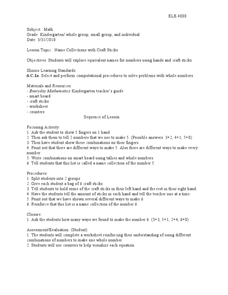Curated OER
Parts of the Plot: Constructing A Plot Diagram
After reading "The King of Mazy May" by Jack London, learners reinforce their literary analysis skills in this SMART board lesson. The provided SMART board file allows themto define elements of a short story, and then add it to the plot...
Houghton Mifflin Harcourt
Smart Solutions: English Language Development Lessons (Theme 6)
Smart Solutions is the theme of a unit created to meet the needs of English language earners. Through a series of lessons, scholars follow a routine—move, speak, and listen— to cover topics including stores, shops, celebrations, pets,...
Curated OER
Lesson Four: Comparatives and Superlatives
Put on your best smile, or a least a better one, for this lesson on superlatives and comparatives. English language learners first fill out a graphic organizer by finding other people in the class who are taller than they are, shorter...
Curated OER
Folk Tales for ESL Students
Using the folk tale "The Man, The Boy, and The Donkey" (linked in the lesson) and a SMART board, teachers can help pupils access multiple skills. Reading the story allows learners to create a timeline of the sequence of events based on...
Curated OER
Sequencing
Young scholars consider how cause and effect translate into sequencing in literary works. In this sequencing lesson, students read non-fiction passages about Eleanor Roosevelt and Clara Barton. Young scholars complete graphic organizers...
Curated OER
Poetry Reading for ELL Beginners
Bring the imagery of the desert to your classroom with this ELL lesson plan. After reading Madeleine Dunphy’s Here in the Southwestern Desert, learners complete a graphic organizer about the features and images of the poem. The...
Curated OER
The Mummification Process
Sixth graders investigate the steps of mummification. For this ancient Egypt lesson, 6th graders listen to a SMART Board aided lecture to view how mummification works as well as the meaning behind the ritual. Students then complete a...
Curated OER
Rainforest Introduction
First graders explore world geography by completing a KWL chart. In this rainforest research lesson, 1st graders read a fictional story discussing a boy who lives in the rainforest. Students analyze the story, identify the plot and...
Curated OER
Ancient Rome (Review)
Ninth graders investigate how Rome evolved from a republic to an empire. In this ancient Rome lesson plan, 9th graders listen to a SMART Board lecture about the Roman Republic and the Roman Empire. Students then play 4 games that require...
Oregon Department of Education
Building and Expanding Patterns
The generation of a number, or shape pattern, is the focus of this math lesson. Pupils are presented with a variety of patterns shapes, and number patterns, then use worksheets embedded in the plan to gain further practice. The...
Curated OER
How Cells Reproduce
Learners explain why cells reproduce and draw a diagram of each of the stages in mitosis. They put the stages of mitosis (interphase, prophase, metaphase, anaphase, telophase, and cytokinesis) in the correct sequence, from the beginning...
Curated OER
Parts of the Plot: Constructing a Plot Diagram
Sixth graders conduct a plot diagram for a short story. They identify the problem, the rising action, the climax, the falling action, and the resolution. Students are able to sequence events in a story, and identify the parts of the plot...
Curated OER
Water and the Water Cycle
Students explore the water cycle. For this water lesson, students apply the scientific method in activities that enable them to take note of the properties of water. Students record how water acts on different surfaces and share their...
Curated OER
Patience
First graders listen to the story New Shoes for Silvia by Johanna Hurwitz. In this literacy lesson, 1st graders do a picture walk and answer who, what, when, where and why questions. Students answer multiple questions focused on...
Curated OER
Butterfly Introduction
First graders create a KWL chart about butterflies and then read a story about butterflies. In this butterflies lesson plan, 1st graders then discuss the life cycle, body, habits, and facts about butterflies as they read.
Curated OER
How Cells Reproduce
Learners construct a mitosis flip book. In this biology lesson, students describe the different stages of mitosis. They discuss the importance of cell reproduction.
Curated OER
Late-In-The-Year Counting
Students practice forward and backward counting. For this counting lesson, students calculate how many objects in a bag by counting forward and then count backward to check.
Curated OER
Konnichiwa! Welcome to Japan!
Students study feudal Japan, the islands of the country, and its religions. In this history of Japan lesson, students complete a 9 lesson unit about Japan, its history, its feudalism, its islands, and its religions.
Curated OER
Identifying Disease Genes using BLAST
Students navigate the National Center for Biological Information (NCBI) website and BLAST program to conduct a variety of biological assignments.
Curated OER
Friendship
Gather your first graders and read Franklin's New Friend. First, show the book's cover and title. What can your youngsters infer from these along? Then read through the comprehension questions you created and start reading the...
Curated OER
Name Collections with Craft Sticks
Groups of Kindergarten students count craft sticks in different groups and name how many they have. They complete simple addition to ten with the use of manipulatives.




















